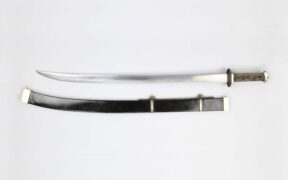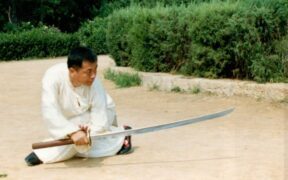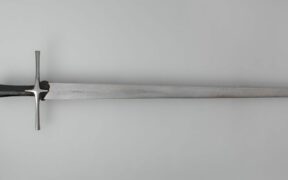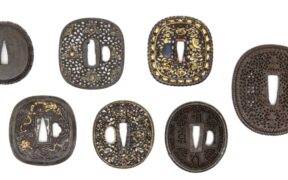Our content features commercial links to our products, committed to transparent, unbiased, and informed editorial recommendations. Learn More
Guandao: Its History, Myth, and Martial Arts Use
NO AI USED This Article has been written and edited by our team with no help of the AI
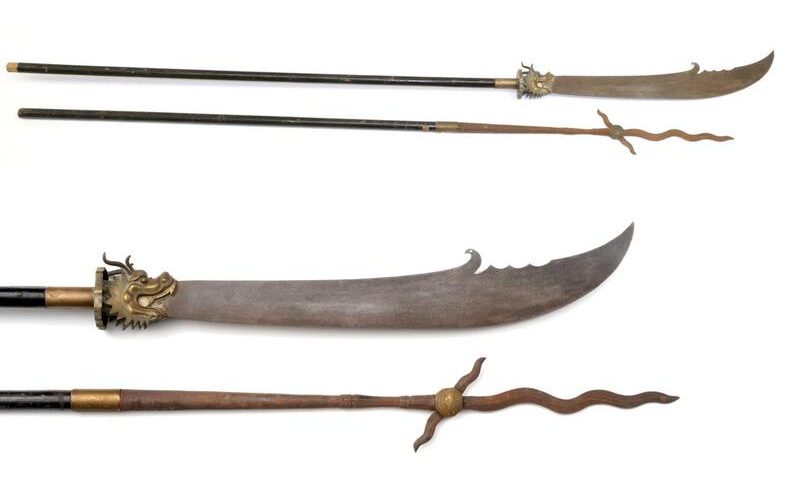
The guandao, also spelled kwan dao or guan dao, is similar to a halberd or a glaive. It is most recognized for its curved blade with a pronounced hook and scalloped spine. It primarily served as a cavalry weapon and was unsuited for the foot soldier. Today, it is most often associated with the legendary weapon of Guan Yu in the historical novel, Romance of the Three Kingdoms.
Let’s explore the history of guandao and its uses in Chinese martial arts.
Characteristics of the Guandao
The guandao is most recognized for its blade form, with a curved and scalloped design. However, blade shape may vary depending on its origin.
Here are the unique characteristics of the guandao:
Metal and Construction
The quality of guandao ranged from good to highly functional weapons. Actual fighting weapons had well-made blades, usually forged iron with a hardened edge plate. There were also ones for ceremonies, parades, and practice. The guandao is rare among antiques, though some replicas feature stainless steel or high-carbon steel blades.
Blade Appearance
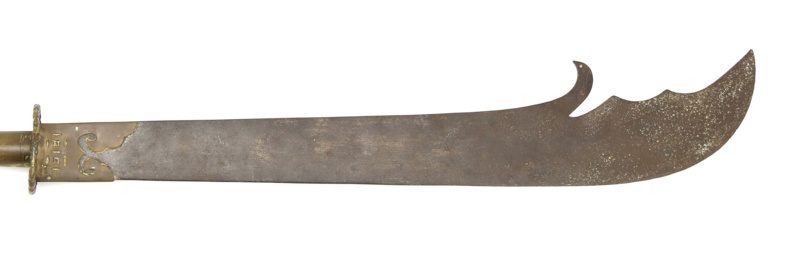
The guandao typically features a wide, curved blade for cutting and a sharp point for stabbing. Its back edge has serrated teeth and a thumb-like notch, likely used for trapping an opponent’s weapon.
Some blades also have symbolic dragon engravings, while others feature a decorative ornament attached to the hole in the spike. Typical examples have wide blades dramatically sweeping backward, though southern Chinese versions often had a relatively straight shape.
Size and Weight
In Qing dynasty regulations, the guandao had a blade length of around 80 centimeters (31 inches) and an overall length of 233 centimeters (91 inches). Its weight varied depending on its use, with those suited for combat weighing less than 5 kg.
On the other hand, the Qing-dynasty guandao used for strength training and testing, the wǔkēdāo, was particularly heavy, around 72 kg. Those used for regular training purposes, such as practicing basic skills, usually weighed about 18 kg.
Weapon Mounting

The guandao features a blade mounted on a simple wooden pole, sometimes with a spike at the other end of the pole. Many Qing-dynasty guandao had blades held by the mouth of a dragon—representing Yazi of Chinese mythology.

However, many Southern Chinese versions lacked a dragon head design. These often featured a stylized tunkou (collar piece) at the base of the blade and a rounded guard.
Facts About the Guandao
The guandao was named after the legendary Guan Yu of the Three Kingdoms Period. The name appeared in Ming texts during the late 16th century and became the most commonly used name for the weapon today. However, it had several alternative names throughout history.
The guandao was first called yanyuedao, meaning reclining moon blade.
In the 11th century, the guandao was referred to as yǎnyuèdāo (掩月刀), meaning covered moon blade. It later got its alternative writing yǎnyuèdāo (偃月刀), which means reclining moon blade. The latter was the most commonly used name in historical texts, particularly military texts from Song to Qing dynasties.
The guandao was also referred to as chunqiudao, meaning spring-autumn blade.
By the 18th and 19th centuries, the term chūnqiūdāo (春秋刀) appeared in Qing military texts, which regulated the production of military equipment of the time. Some also used the other name yanyuedao, likely due to regional preferences.
The guandao was ideal for fighting on horseback.
Wielding the guandao required great strength. The Muye Dobo Tongji, an ancient Korean martial arts manual, is based on the Ming Dynasty Chinese manuals of that time. It recorded the use of the guandao on horseback. Mounted enemies had difficulty defending against the weapon as they were unable to change position quickly enough.
The Green Dragon Crescent Blade is the mythical version of the guandao.
The qīnglóng yǎnyuèdāo (青龍偃月刀) or Green Dragon Reclining Moon Blade is the weapon of the legendary General Guan Yu. It has the length of a spear and the chopping power of a sword. It appears in the historical novel Romance of the Three Kingdoms, though the actual weapon emerged during the Northern Song dynasty, around 800 years after the time of Guan Yu.
The guandao is among the oldest weapon forms in Chen-style taijiquan.
The guandao was the preferred weapon of Chen Wang Ting, the founder of Chen-style taijiquan. Also, its form is unique as each movement is given a seven-character poem or song associated with General Guan Yu. Every time the guandao form is practiced, his exploits are also re-enacted.
In Shaolin kung fu, guandao is sometimes called guan knife.
In the West, the term knife refers to a smaller utility tool. However, the Chinese also use the term knife for heavier and tougher weapons, usually single-bladed. On the other hand, they use the term sword to describe light and dainty double-bladed weapons. The guandao, also called guan knife, belongs to the category of long, big knives.
The Chinese guandao is similar to the Vietnamese yem nguyệt đao.

The yem nguyệt đao is the Vietnamese equivalent of the Chinese polearm guandao, distinguished for blade form. Chinese rituals deeply influenced the Nguyen dynasty of Vietnam, which preserved them even after the Ming dynasty fell. Some of these included the designs of ceremonial weapons usually made of wood, including the yem nguyệt đao.
Guan Yu and His Guandao
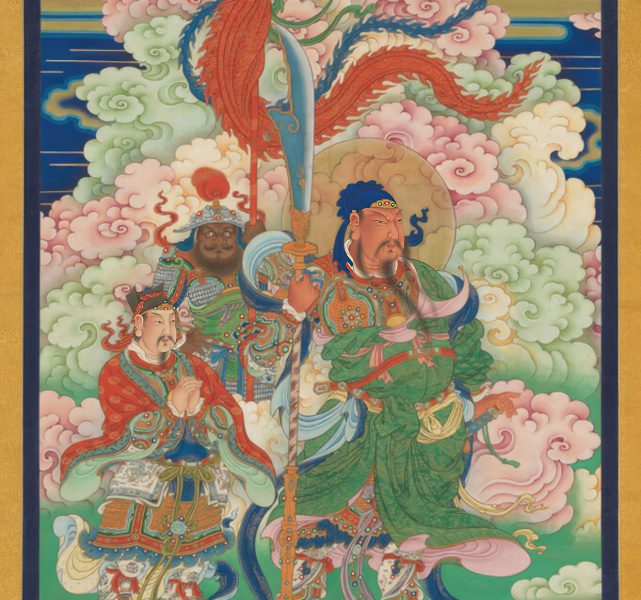
Statues and illustrations of the legendary Guan Yu depict him with the guandao. General Guan Yu played a role in the civil war that led to the fall of the Han dynasty. He worked as a general in a series of military campaigns during the Three Kingdoms era of China—the Wei, Wu, and Shu.
During the Ming dynasty, the historical novel Romance of the Three Kingdoms popularized his adventures and his guandao as Green Dragon Crescent Blade. In 1594, the Ming dynasty emperor canonized Guan Yu as the god of war named Guandi or Guan Gong. In modern times, the Chinese regard him as a symbol of bravery, loyalty, and righteousness. He is a revered figure in Confucianism, Buddhism, Chinese folk religion, and his image appears in many Taoist shrines.
History of the Guandao
Throughout history, the guandao served as a battlefield weapon and training tool. By the Qing dynasty, it became a ceremonial weapon carried by high-ranking officials during parades.
The Wǔkēdāo in Military Training
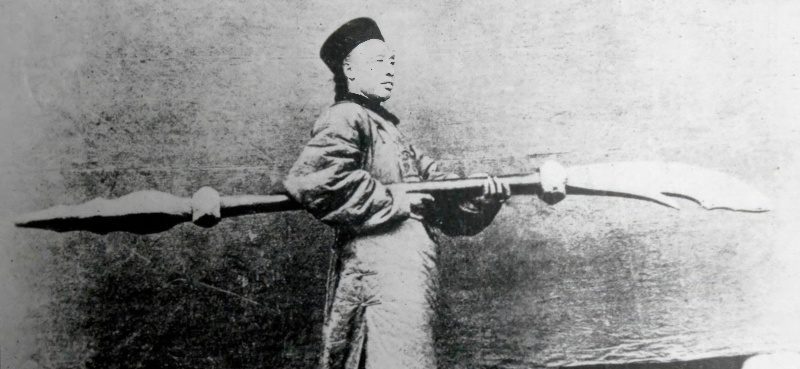
The wǔkēdāo (武科刀) or Military Exam Blade was an exceptionally heavy guandao. In the Qing military, it served as a training tool to build up strength. In military examinations, each candidate of the Green Standard Army performed a simple form with it.
Generally, heavier versions helped in mastering fighting skills but cannot be easily manipulated in actual combat. The guandao was only used for mounted combat after the warrior had mastered its use on foot.
In Chen Style Taijiquan
The founder of Chen-style taijiquan, Chen Wangting preferred the guandao as a weapon. Chen-style is the oldest of the five family styles of taijiquan. Chen Wanting was a Ming dynasty general and a Qing dynasty scholar. In Shandong Province, he was the master of martial arts. Since he mastered the guandao and had a long beard, he acquired the nickname “Second Master Guan,” after Guan Yu.
The Chen-style taijiquan is one of the most dynamic Chinese martial arts where the guandao aids the practitioner in mastering different movements. Apart from hand forms and standing pole exercises, practitioners undergo weapons training. The guandao form has 13 fundamental techniques, mostly chopping movements.
The Shaolin Monks and the Guandao
The Shaolin monks have a fearsome reputation due to their fighting skills. In 621 CE, the Shaolin monks defeated Wang Shi Chong at the Battle of Hulao. According to their Buddhist principles, Shaolin monks practice nonviolence, though they became skilled practitioners of martial arts and used various Chinese weapons.
The guandao is one of the weapons used in the 18 Arms of Shaolin kung fu. Originating from ancient military weapons and adapted farming tools, the four most important were staff, broadsword, spear, and straight sword. The other popular weapons include the monk’s spade, halberds, gou (hook), crescent-shaped zi-wu (deer-horn knives), and nine-sectioned steel whip.
The Guandao in Modern Times
The guandao is among the training weapons used in taijiquan and Shaolin kung fu. In Chen-style taijiquan, the guandao is an efficient weapon for developing core skills. As a large and heavy weapon, it requires powerful movements such as cutting vertically, horizontally, circular cuts, piercing, intercepting, and raising the opponent’s weapon’s overhead.
In Shaolin kung fu, modern warrior monks display their skills by wielding the guandao. The weapon typically requires great strength in the arms, shoulders, and a good sense of balance. Shaolin fighting techniques have inspired hundreds of martial-arts systems around the globe. Today, some Shaolin monks still train in the traditional arts.
Conclusion
The legendary weapon of General Guan Yu was a guandao known as Green Dragon Crescent Blade. It is widely known today as guandao but had several alternative names, from yanyuedao to chūnqiūdāo. Today, it remains one of the most iconic weapons used in Chinese martial arts, including Shaolin kung fu and Chen-style taijiquan.
